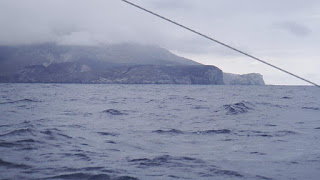We left St Helena on 7th March. We’d checked the weather and saw that we needed to make the most of the wind in the first few days as it was likely to be lighter later on. We sailed slowly with the wind speeds ranging from 7-12 knots ESE to SE. From time to time there would be a squall bringing sudden bursts of wind up to 20+knots. We flew our ghoster (a light wind sail – like half a spinnaker) but nearly always struggled to take it down when a squall arrived. It was very hot without the cooling wind, but the calm seas meant we could have portholes and hatches open. It was too hot to wear clothes. We were glad we had a bimini and awnings to give us some shade.
We were on our way to French Guyana admiring the superb display of stars and planets at night. Venus and Saturn shone in the western sky after sunset until the moon rose and lit up the sky. We had stowaway seabirds that spent the night on our radar mast, pulpit rail and safety rails.
 |
| Stowaway sea bird |
 |
| Broken masthead block |
 |
| Approaching Ascension |
Next morning at 0800, Jeremy was up the mast replacing the block. We were allowed to go ashore for essential supplies. We paid £15 port fees and £3.20 for water. We were taken by car to see the police, who act as Immigration, and allowed to buy food at the supermarket. Back on SD, we were strongly advised not to swim as there have been recent shark attacks. We heeded the warning.
 |
| The offending block |
 |
| French Cat Marrant, Clarence Bay, Ascension |
We anchored off the harbour at Fernando on Saturday 25th March. The Canadian yacht, Kiaja Song, which we’d first met in Cape Town and again in St Helena, had already been at anchor for four days. They were very helpful in giving us information about Fernando. We launched the dinghy and went ashore to the Port Captain’s office. He was most helpful and used Google Translate to communicate in English. Immigration came and stamped us in and out. The officer took us to the nearest ATM in his car and directed us to the nearby supermarket. After buying a few supplies, we took a taxi back to the port and retuned to SD. At 1400 hours we were back in the Port Captain’s office filling in forms for the Brazilian Navy, observed by three navy officials.
 |
| Improvised Brazil flag using Ellie's vest and crayons |
 |
| Fernando de Noronho |
 |
| The dreadful weed |
We used up all but our last tank of diesel motoring north to find the NE Trades. We crossed the Equator and shared brandy and biscuits with Neptune. At about 3 degrees north, the wind began to blow from the N and NE. Jeremy went down with a cold and sore throat first. Then it was my turn. A winch broke off from the side of the mast and dropped to the deck. Fortunately, we don’t use it very much and could continue without it. The new port side genoa sheet chafed on the clew of the sail, probably against a shroud. It’s a little shorter now but still okay to use.
We had a discussion after realising how far behind our schedule we were. It was decided to miss French Guyana and make directly for Barbados. The cooking gas ran out. Jeremy changed the bottle, so we’re now on propane. It was a relief to be sailing again with fewer squalls. We had no eggs for Easter. I was able to put together an Easter Treasure Hunt and smiles were brought to our faces as Jeremy searched for “treasure” (a cereal bar, which he shared with me – aahh.)
 |
| Sunset at sea |
On Friday, 14th April, we approached Bridgetown, Barbados and called on the VHF for permission to enter the port. Everyone had gone home as the last cruise ship had left. We knew that Health, Customs and Immigration were on duty until 2200, so we entered the port and tied up in front of catamaran Pivot Point with Conrad from Buffalo River YC, East London on board and other crew. A voice shouted, “Hello Jeremy!” and two men helped us tie up to the cruise ship dock. We had last seen Pivot Point in St Helena when Jeremy helped them to tie to one of the moorings.
With
the help of rope ladders, we scaled the dock and cleared in with the
officials. Afterwards, we cast off and motored to Carlisle Bay and
anchored. We were just in time to see the last rays of the sun
disappear over the horizon as we celebrated our second
circumnavigation of the world with beers.

2 comments:
Congratulations Sal Darago on her second lap, despite the recent travails! Did you ever find the West Pole?
Enjoy spring in the Caribbean. Love Patch xx
Thanks Patch. Good to hear from you.The West Pole......well there was no line on the sea that said Greenwich Meridian....disappointing! Had to rely on our charts and GPS.
Take care. Love to all,
Kathy xxx
Post a Comment